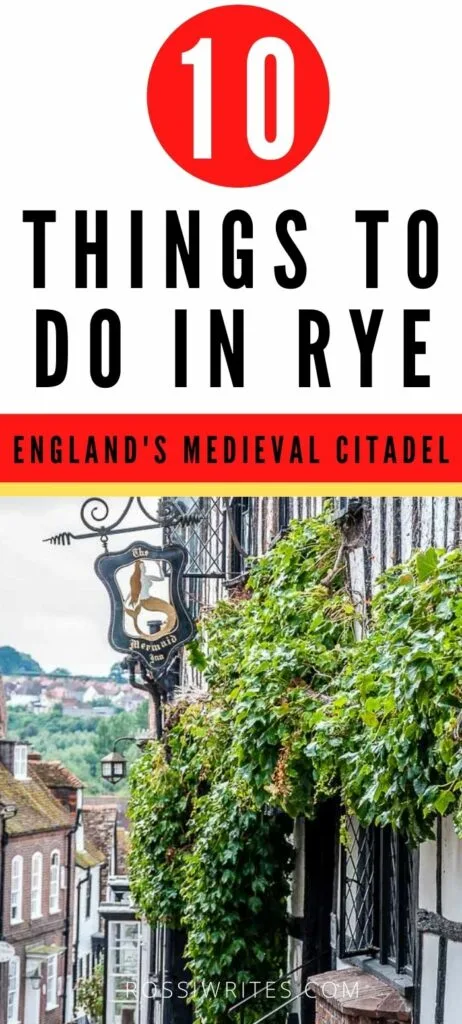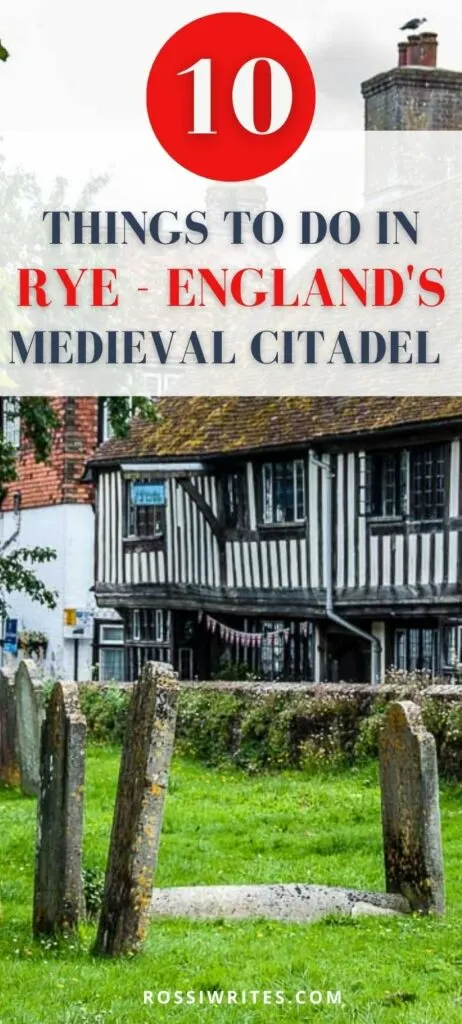Here are the ten best things to do in Rye in England.
Rye is a pretty as a picture town in the English county of East Sussex.
It’s built on top of a small hill at the meeting spot of three rivers and nowadays, it stands about two miles inland from the English Channel. In the distant past, Rye was an island. During the Middle Ages, the town became an important seaport and a constant point of contention between the English and the French. Surrounded by strong defensive walls, Rye was a powerful citadel that, throughout the centuries that followed, attracted seafarers, shipbuilders, smugglers, and even famous writers.
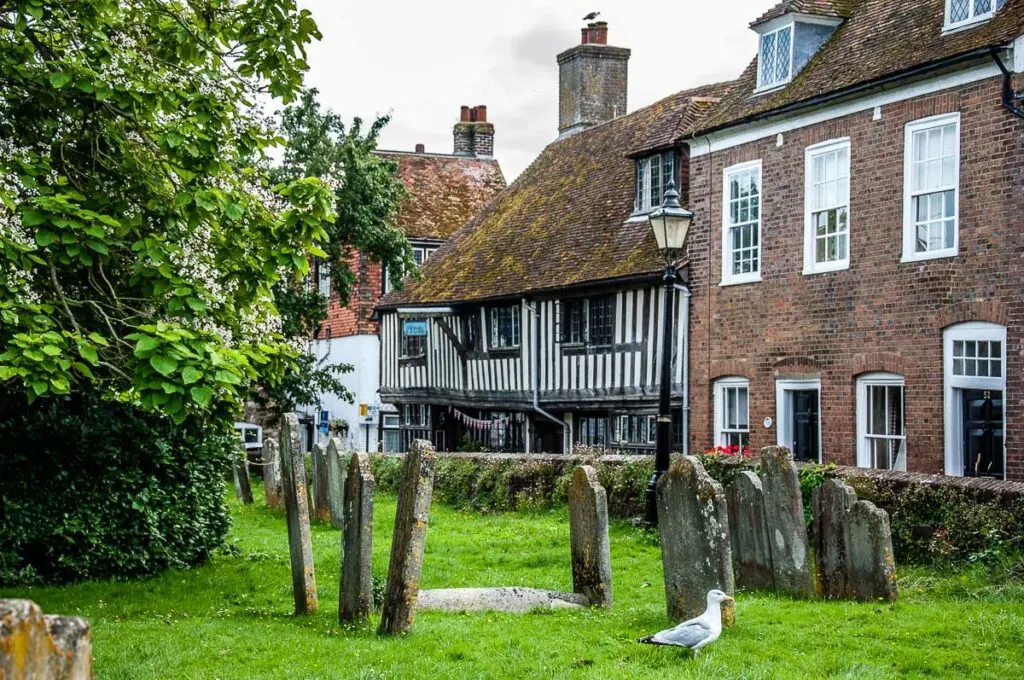
Today, the town is a dream of crisscrossed cobbled lanes and picturesque houses in different architectural styles. From half-timbered facades in black and white to proud Georgian and Victorian buildings, Rye is a great place to visit in order to immerse yourself in the history and the beauty of England.
Easy to reach by train or car from the capital London and from anywhere in the counties of East Sussex, Kent, and West Sussex, Rye is the perfect English day trip or weekend break. Expect historic sights, unique natural landscapes, and plenty of quirky shops and eateries. And while the town is no longer an island due to the silting of the river estuary, in its immediate vicinity you will find some of England’s prettiest beaches. Great for topping up your Vitamin D reserves in summer and for windswept walks in any season.
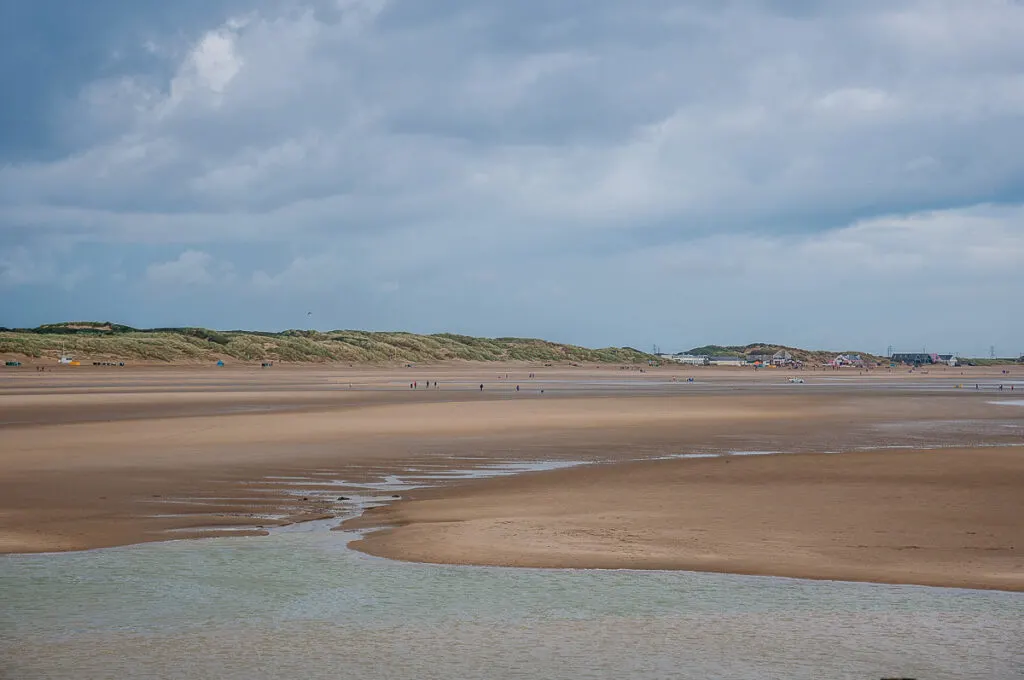
Rye was one of the first day trips we took when we moved back to England after spending six years in Italy. The town charmed us with its pretty hilltop centre, deep layers of history, and the perfect ratio of quirkiness to modern amenities. There is lots to do and see here, yet you can take it very easy. Simply walking up and down the cobbled streets and taking in the beauty of the many centuries-old facades is the best part of sightseeing here.
You can stop for a meal in a pub that existed back in the Middle Ages, scale the narrow steps of the parish church’s bell tower for breathtaking views, explore a Tudor fort, and go for a walk in the nearby nature reserve right on the shore of the English Channel. Or you can shop in the local boutiques stocking whimsical items that make imaginative gifts for friends and family or simply to yourself.
It is so easy to fall in love with Rye. It is one of England’s still hidden gems. While its historic Mermaid Street has lately become an Instagram favourite on account of the ivy-clad Mermaid Inn with its iconic sign, the town is very much underrated and yet it has so much to offer to the curious traveller.
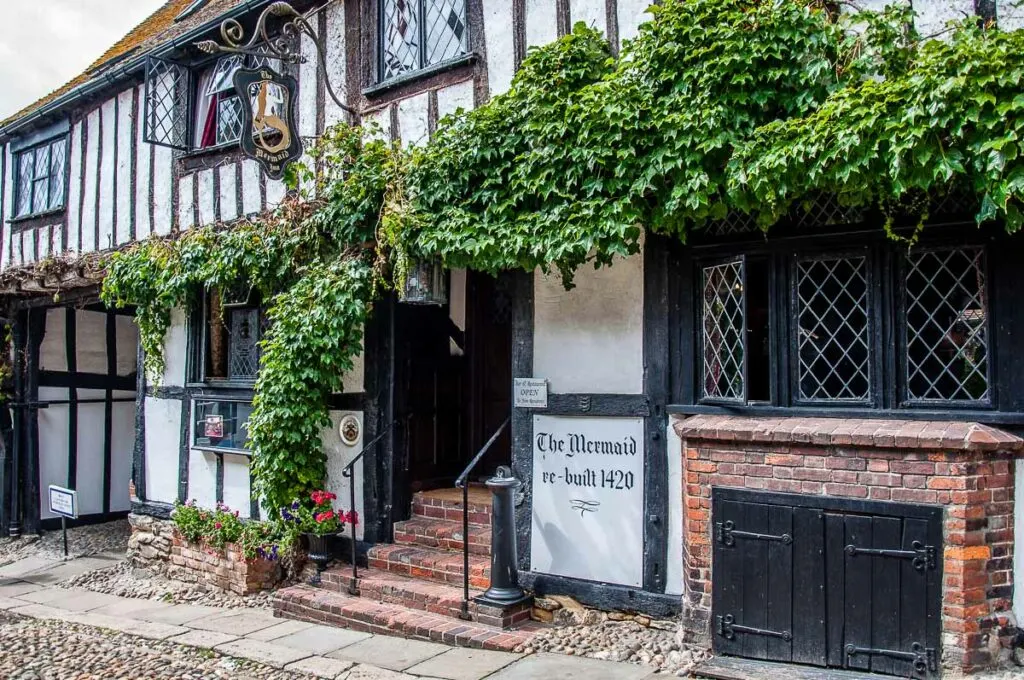
So, in this blog post, I want to share with you the ten best things to do in Rye in England. In any season and weather, this small town in East Sussex is an exciting destination. No matter what your interests may be – history, photography, shopping, food or nature – Rye delivers on all accounts.
In addition, at the end of this blog post, I have also included a section with lots of practical travel tips. From how to reach Rye to where to park and how to navigate this ancient town, all sorts of useful details are covered. This way you can easily and quickly plan your day trip, weekend break or longer stay in Rye, England.
Have a look!
10 Best Things to Do in Rye – England’s Medieval Citadel
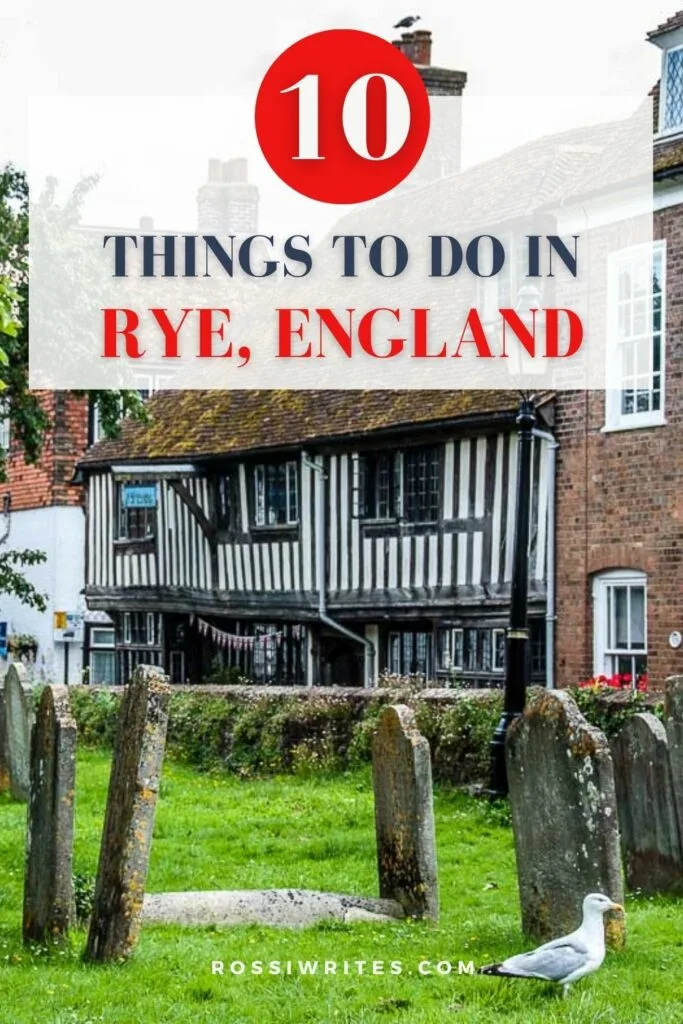
1. Explore the Ancient Town Citadel of Rye, England
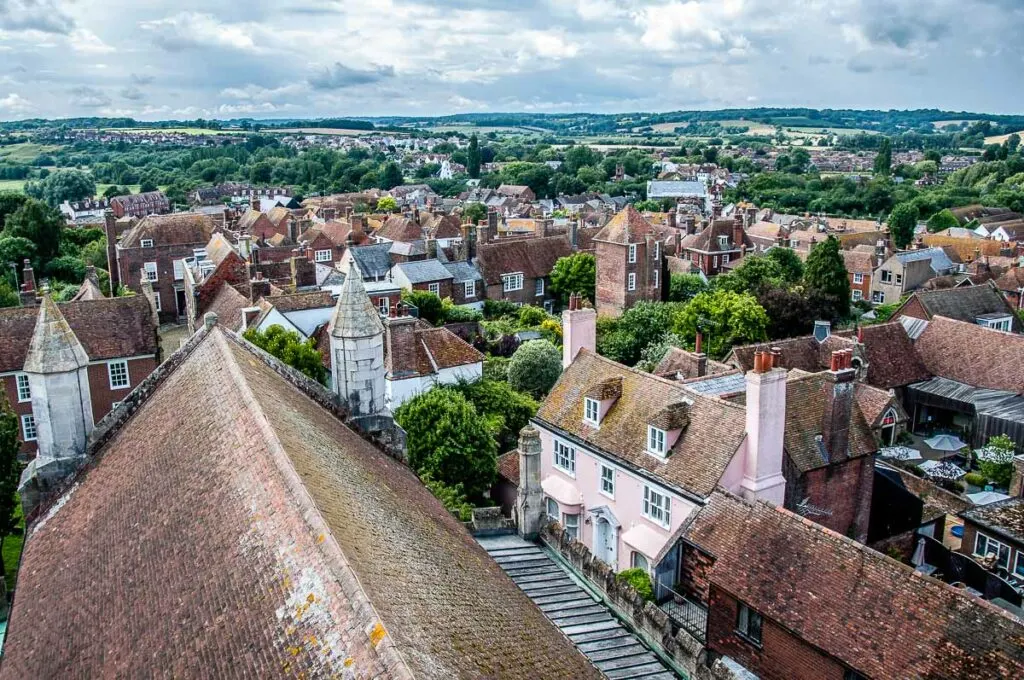
Rye is a very interesting English town from many different points of view. When I first saw it, the thing that made the biggest impression on me was that Rye is built on a small hill that, centuries ago, used to be an island. As you drive into town, you see the houses going uphill and the ancient part of Rye seems to have a somehow oval shape giving you an idea of what the town must have looked like in the Middle Ages.
Medieval Rye was a heavily fortified citadel with a defensive wall around its perimeter. While only remnants of the wall survive to this day, Rye’s old town is still known as the Ancient Town Citadel.
Rye’s old town is a very picturesque place. Here, cobbled lanes crisscross the hill and are lined up with centuries-old houses. Every corner here hides a different surprise and every step reveals yet another small detail to intrigue you or a dramatic view to take your breath away.
Going for a walk through Rye’s old town is a must even if you have only a limited amount of time to spend here. In any way, most of Rye’s major sights are within the confines of the Ancient Town Citadel. Yet, don’t simply rush from one sight to the next. Here, simply walking the streets and taking in the beauty of the historic facades is already an experience in itself.
The best way to see for yourself how the geography and the urban plan of Rye have changed throughout the centuries is to visit Rye Heritage Centre. The star attraction in this small yet must-see place is a model of the town. A special light and sound show illustrates the evolution of Rye over the millennia.
2. Walk Up Mermaid Street in Rye, England
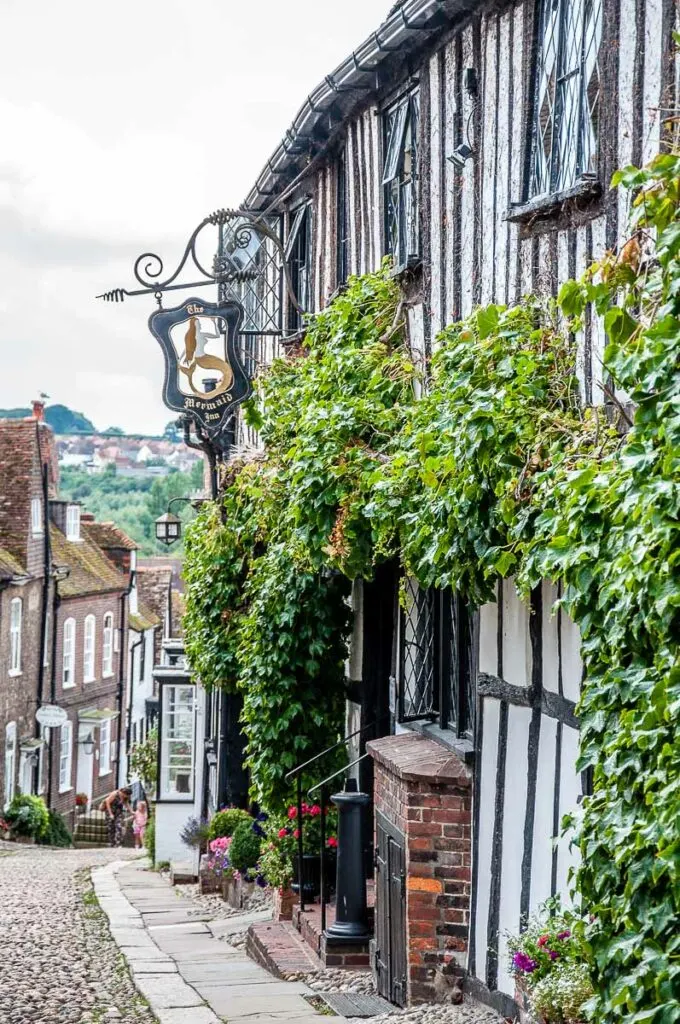
Mermaid Street is the most famous and iconic street in Rye, England. Photos of its cobbled lane and its ivy-clad half-timber houses circulate on social media drawing gasps of admiration. It’s not in vain that Mermaid Street has been named one of the most instagrammable places in the whole of Britain!
You will find Mermaid Street right in the heart of Rye’s old town. It starts from the Strand (where there is a convenient car park) and it scales the elevation of the hill on which Rye stands. It stretches almost all the way up to the town’s parish Church of St. Mary the Virgin.
Walking on the cobbles here is akin to visiting an open-air museum. On both sides of Mermaid Street, there are houses that date as far back as the start of the 15th century. Had it not been for the French who raised Rye to the ground in 1377, the houses here would have been from the 11th century.
Such is, for example, the case of the famous Mermaid Inn on Rye’s Mermaid Street. Originally built in the 11th century, it was then burnt in 1377 with only its cellar surviving the attack of the French. The inn was rebuilt in 1420 and it is still going strong to this day. Its sign with a mermaid with a twisty tail features in all iconic photos of Rye.
Yet, there are many more beautiful and wonderful buildings along Mermaid Street in Rye. My favourite one had a stunning black and white half-timbre facade and in a former life had been a hospital.
3. Visit the Parish Church of St. Mary the Virgin in Rye, England (and Enjoy the Views from Its Bell Tower)
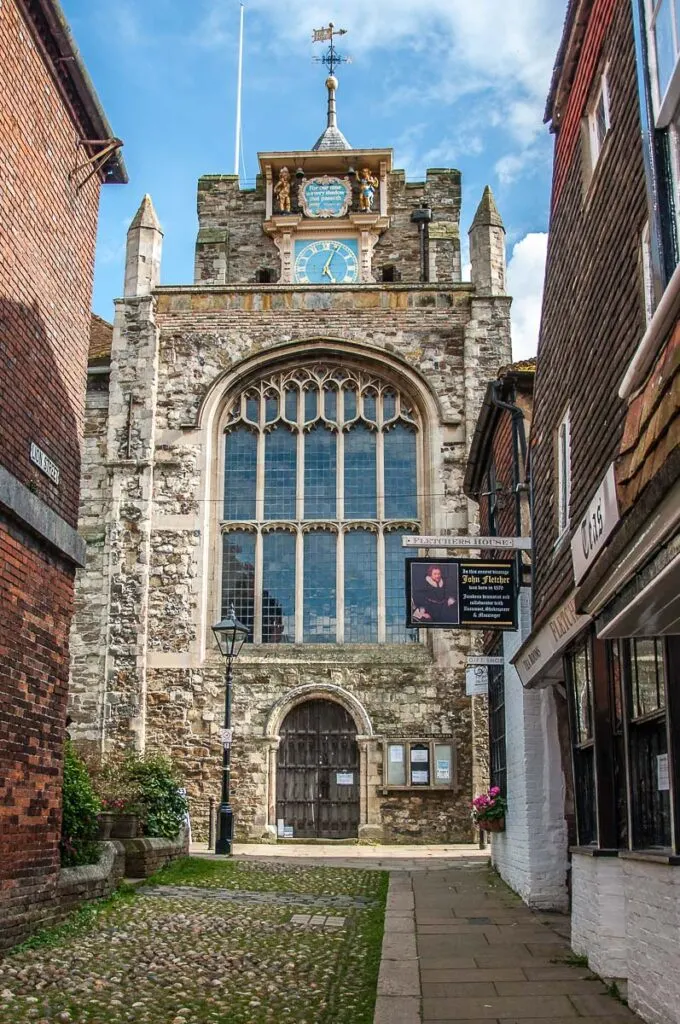
The Church of St. Mary the Virgin is Rye’s main Christian sanctuary. It stands on top of the small hill of Rye’s old town. If in the world all roads lead to Rome, in Rye all roads seem to lead to St. Mary’s Church.
The church was built in the 12th century. Its oldest part is the chancel. It was completed around 1120. At the time, Rye was under the rule of the Abbey of Fecamp in Normandy, France. In 1247, Henry III reclaimed Rye for the British crown. When the French attacked the town in 1377, the Church of St. Mary the Virgin was badly damaged. Yet it was one of a handful of buildings that survived the almost complete destruction of the town.
Since then, the church has had a central role in the history of Rye. After the Second World War, it underwent significant restoration and reinforcement. Nowadays, its large stone body feels spacious and light inside. This feeling is elevated by the church’s large windows with stunning stained glass compositions.
Stand in the middle – the so-called Crossing – of the church and you will hear a constant tick-tock, tick-tock. Lift your gaze and you will see an 18 feet long pendulum moving tirelessly from side to side. While the pendulum dates back to 1810, it is part of a clock from 1561/1562. It is one of the oldest church tower clocks still in use in England. Some even say that it’s the oldest! You can see the clock’s mechanism up close if you decide to climb to the top of the church’s bell tower (currently, £4 per adult).
For this, you will need to navigate about 80 steps and a couple of very narrow passages. It’s very exciting! Once you reach the top of the bell tower, you can enjoy gorgeous 360-degree views of Rye’s rooftops. Beyond them, you can see lush green hills, the rivers Rother, Tillingham, and Brede, and even the English Channel. Standing up there and taking in the panoramas was my most favourite experience in Rye.
If you have a special interest in religious buildings, then make sure that you also visit the Catholic church in Rye. It’s dedicated to St. Anthony of Padua. I spent six years living in Italy in a city very close to Padua. I used to go to Padua all the time to explore its sights and spend time in its lovely coffee shops. Padua’s Basilica of St. Anthony was one of my favourite destinations in the city. So, coming across the name of the Paduan Saint in Rye was a great surprise. Somehow, I felt that our visit to this beautiful English town was a great link to our former Italian lives.
4. Marvel at the Ancient Water Cistern in Rye, England
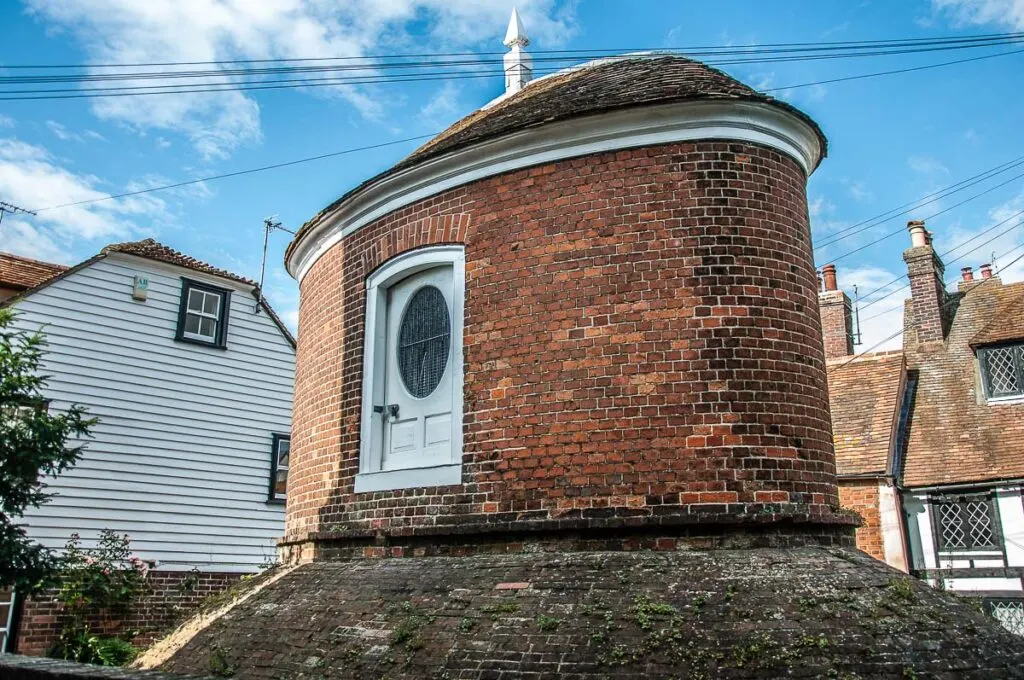
Rye is full of whimsical details. Everywhere you look, there is something surprising waiting for you to discover the history and the traditions behind it.
One such sight in this small English town is its Ancient Water Cistern. It stands right next to Rye’s Church of St. Mary the Virgin. The cistern is built of bricks and has an oval base that protrudes from the ground. It is then topped by a short oval tower with a door in it. Below ground, there is a large water tank.
There was a water cistern in the churchyard as far back as 1548. The one we see there nowadays was built in the first half of the 18th century.
The local annals testify that in 1733, the Mayor of Rye asked permission to place a water cistern for public use in the corner of the churchyard. The Bishop swiftly agreed with the proposal. By 1735 the structure was completed. In April of the same year, a committee was appointed to enquire the households of Rye if they wished water to be supplied to their houses.
A prime example of Georgian brickwork, Rye’s water cistern was a great technological advance for its time. At its heyday, it stored over 90,000 litres of water at a maximum depth of 2,4 m. Nowadays, it is a Grade II listed building and a Scheduled Ancient Monument.
5. See Rye Castle Museum and Ypres Tower in Rye, England
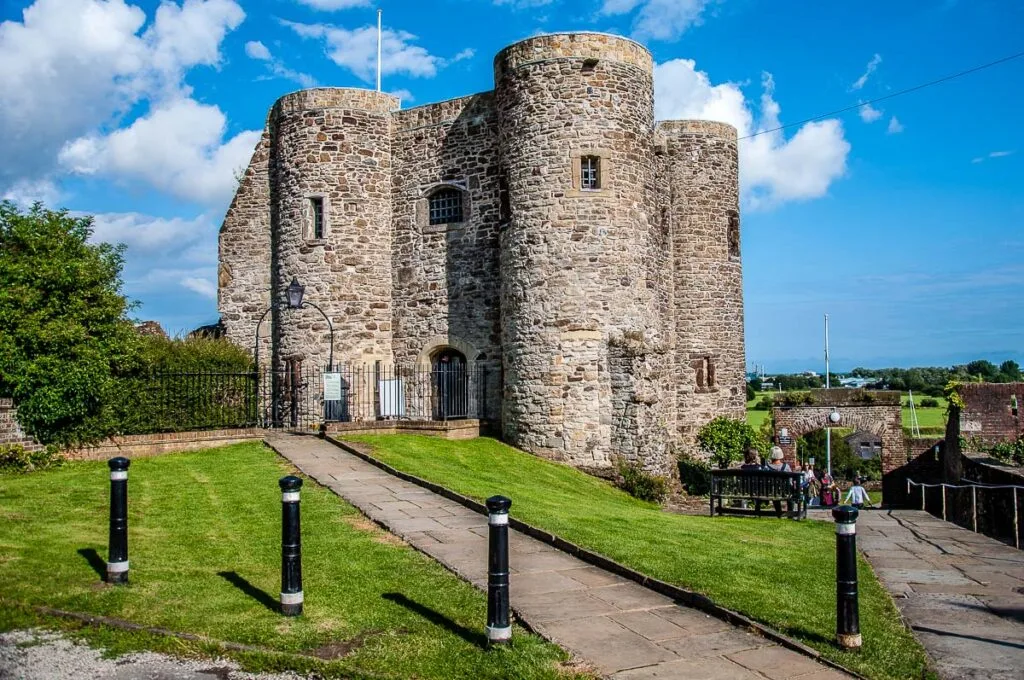
Rye Castle Museum tells the story of Rye from pre-Roman times through Norman and medieval events to our days. The museum has two locations:
- RCM Ypres Tower – this is a sturdy 13th/14th century castle just a step away from Rye’s parish Church of St. Mary the Virgin. Over the centuries, the castle was used as a fortress, prison, courthouse, mortuary, and private residence. Nowadays, it has a replica of a medieval herb garden and an interesting collection of artefacts. Its rooftop terrace opens panoramic views over Rye’s old town and the estuary of the River Rother.
- RCM East Street – this is an old building that stands just up the road from Landgate (see point 7 below). A visit here is a must if you want to learn about Rye’s history from shipbuilding to smuggling.
6. Get to Know the Story of Lamb House in Rye, England
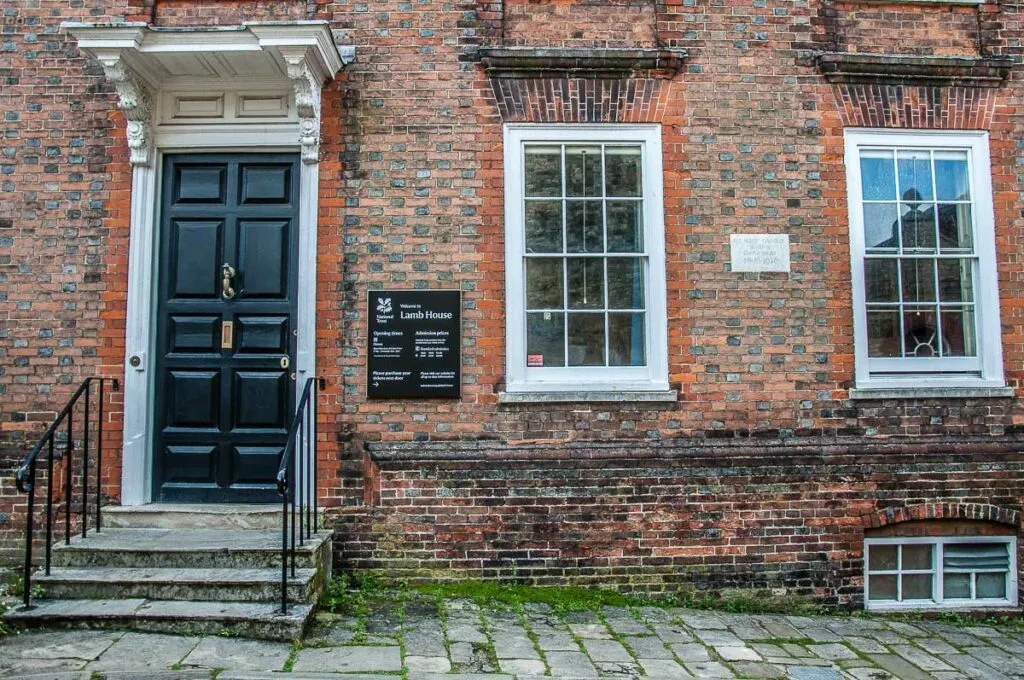
Lamb House is a red-brick Georgian building that stands in the very heart of Rye’s old town. Just around the corner from the top end of Mermaid Street and a stone’s throw away from the parish Church of St. Mary the Virgin, the house commands the gaze with its solid symmetrical facade.
Built in 1722 by the prominent local politician James Lamb, the house has hosted King George I and many writers. The most well-known of them is the American novelist Henry James – the acclaimed author of The Portrait of a Lady.
King George I spent a night in Lamb House – at the time Rye’s principal mansion – in 1726 after a storm run ashore his ship. The story goes that James Lamb gave his bedroom to the king while on the same night Mrs Lamb gave birth to the couple’s baby boy. The boy was named George and the king became his godfather.
Henry James first leased Lamb House in 1897 and bought it in 1899. It is here that he wrote three of his novels – The Wings of the Dove, The Ambassadors, and The Golden Bowl.
Nowadays, Lamb House is in the ownership of the National Trust – a charity for heritage conservation in England, Wales, and Northern Ireland. The house and its walled garden are open for visits. They tell the stories of Henry James’ years in Rye as well as of the many other writers and personalities who have called Lamb House home over the years.
The house itself has been featured in books and TV films and, they say, there have been ghost sightings in it throughout the years. Thankfully, I didn’t see anything of the kind when there, as ghosts terrify me.
7. Walk Through Landgate in Rye, England
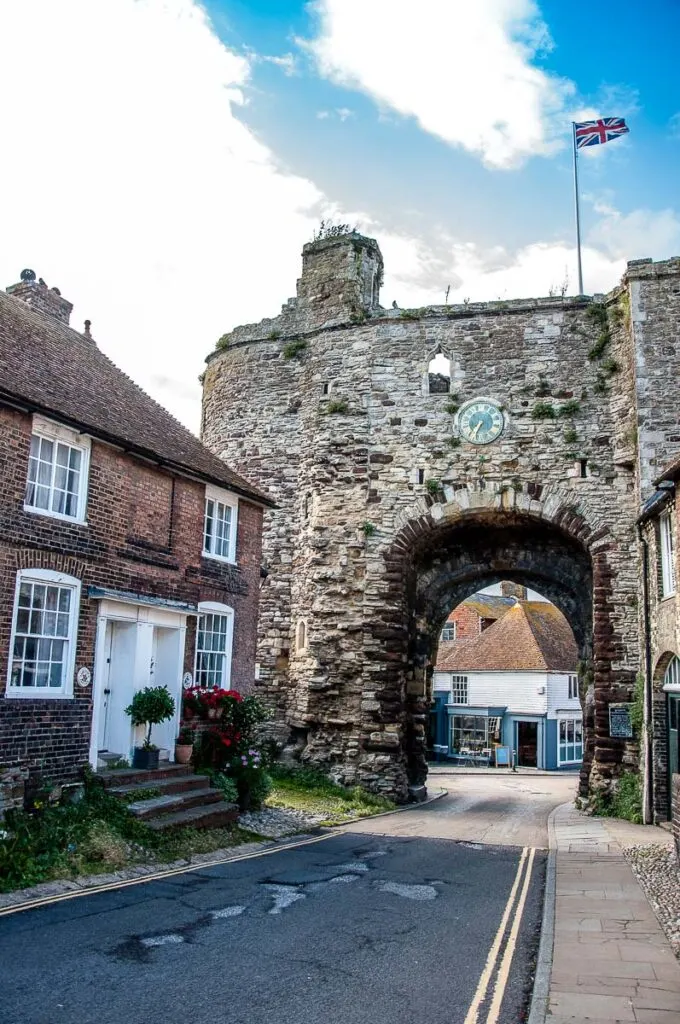
Langdate is a stone arch gateway on the edge of Rye’s old town. Built in 1329, it is all that survives of the original four gates in the ancient defensive walls that used to encircle the citadel on the then-island.
Many centuries ago, Landgate provided the only connection with the mainland during high tides. Its centuries-old name testifies to its original purpose. Nowadays, this sturdy gate is one of Rye’s historic landmarks. Cute houses with windowsills draped in blooms flank the gate.
It’s a lovely place to see on your walks around Rye’s town centre. It’s very close to Lucknow Place car park (a convenient spot to leave your car at for the day) and to a large playground (if your kids need a bit of a runaround after all the sightseeing).
8. Browse the Shops and Stop at the Eateries of Rye, England
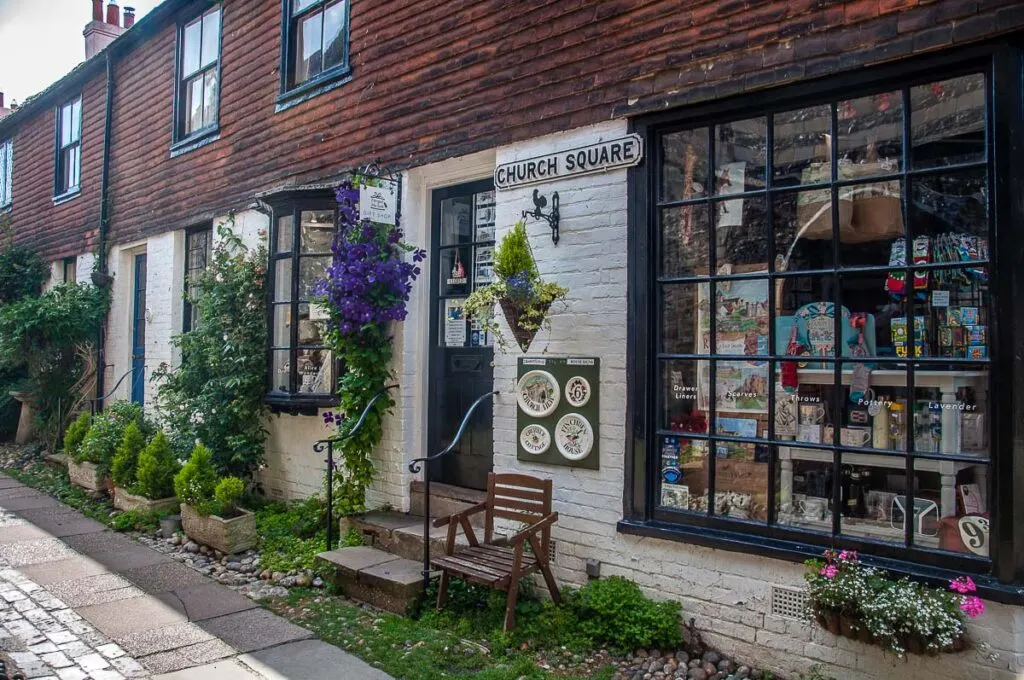
Rye is truly a wonderful place to visit if you like shopping for quirky gifts and whimsical art. As well as if you like good food!
Rye’s town centre is dotted with wonderful art galleries and independent shops selling carefully selected lines of gifts. English towns often have these soulless high streets crowded by multinational companies selling cheap fashion and homewares. Rye, however, has managed to preserve its original character by fostering small, independent boutiques and galleries.
In terms of food, you will be spoilt for choice, too. The local eateries, restaurants, and pubs serve traditional English grub and many different world cuisines with Italian food being particularly abundant. Elegant coffee shops are easy to find here, too. The Apothecary is particularly atmospheric.
There are also a couple of historic pubs in town. I already mentioned Mermaid Inn under point 2 above. Here you can enjoy breakfast, lunch, and dinner in a 600-year-old setting where centuries ago powerful smuggling gangs would meet to plan their raids. The Giants’ Fireplace Bar and the Tudor Bar are very popular with locals and visitors of Rye. The Mermaid Inn serves fine food and wine, a great selection of local ales, 52 gins and over 90 whiskies.
The Old Bell Inn is the other historic pub in Rye, England. It was built in 1390 and an 80-year-old wisteria tree provides a pleasant fragrant shade on its terrace. The Mermaid Inn and the Old Bell Inn are connected by an underground tunnel that in the past was used for the smuggling activities of the 18th-century Hawkhurst Gang.
Rye Waterworks Micropub is nestled in a former water pump house. It’s a very popular place serving local ales and it makes for cute photos with traditional English pub charm.
Simon The Pieman is Rye’s oldest tearoom. It stands right next to the parish Church of St. Mary the Virgin. The tearoom was opened in 1920 and it has been run by the same family since 1988. Come here for a light lunch and delicious homemade cakes and fudge. The large fireplace decorated with a selection of old copper pots adds even more character to the premises with exposed beams and vintage photos.
9. Go for a Walk in Rye Harbour Nature Reserve just outside Rye, England
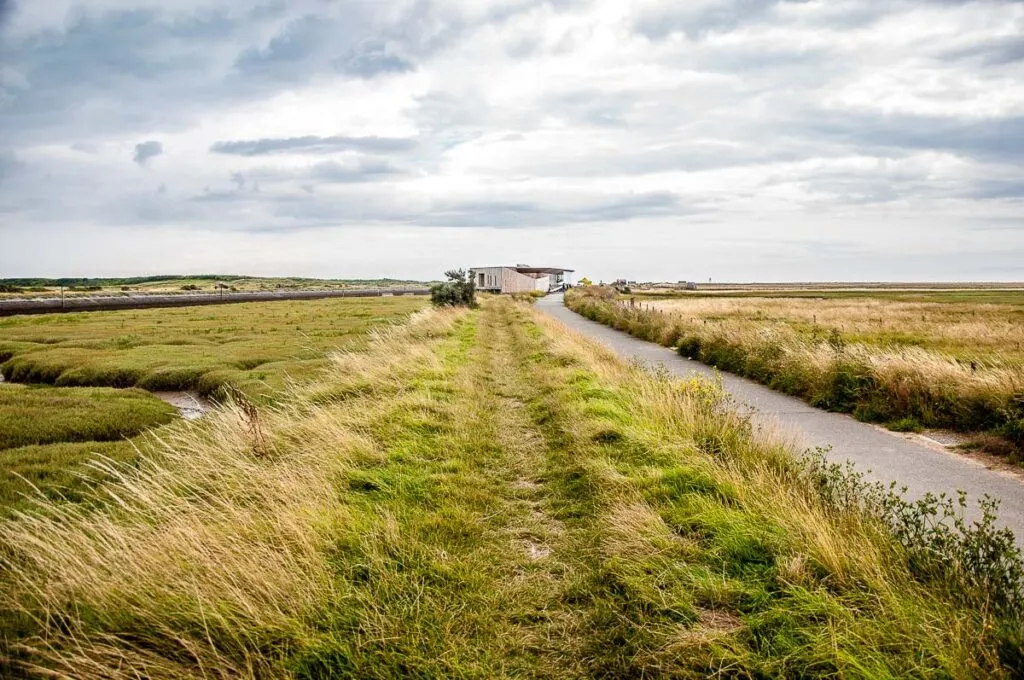
Rye Harbour Nature Reserve is in the immediate vicinity of Rye and is a great place for a bracing walk. Here you can see over 4,355 species of animals and plants. 300 of these are rare or endangered. There is even a colony of seals that calls this place home.
The nature reserve includes both wetlands and coastal areas and it’s one of the largest and most important wildlife sites in England. Centuries ago, this was an expansive natural harbour where boats were built, commerce flourished, and military buildings were erected to protect the coast of England from attack. At that point in time, the town of Rye was one of the finest ports in the country and was part of the Cinque Ports – a medieval confederation of important English coastal towns.
In the centuries that followed, violent storms and river silting filled up the harbour and nowadays Rye lies about two miles inland. The resulting flatlands and marshes are a very interesting place from a naturalistic point of view. The Rye Harbour Nature Reserve was established in 1970 and it includes a wide variety of different habitats – from saltmarsh and scrub to woodland.
A brand new Discovery Centre was opened here in 2021. Its exhibition area introduces you to the many different species of plants, birds, and other animals which call the nature reserve home. There is also a lovely onsite cafe.
Visiting Rye Harbour Nature Reserve and its Discovery Centre is free of charge. There is a large car park that is also free to use, although donations are welcome. Several footpaths cross the reserve so that you can go for a nice walk through the marshes and along the shore of the English Channel. The footpaths are flat and very easy to navigate by walkers of any age.
The wide-open views of the English Channel are fantastic and there are several historic sites to see on your hike. Among them are:
- Camber Castle – a 16th-century Tudor fort built by Henry VIII to protect the coast of England from French attack before the silting of the area left the castle inland.
- Martello Tower – a small defensive fort from the 19th century. You will see it draped in ivy right next to the car park.
- World War Two Pillboxes – small buildings designed to house gun batteries protecting the shoreline.
There is also a birdwatching hide and an over a century-old beach hut with a red roof and black walls that locally is known as Little Red.
You can easily reach Rye Harbour Nature Reserve from Rye either by car or by public transport (buses 312 and 313). If you are spending a long day or a long weekend in Rye, a walk in the nature reserve is a must. The views are beautiful. The human and the geographic history of the place are riveting. And it is very interesting to see in place how the shoreline has changed throughout the centuries.
10. Top Up Your Vitamin D Reserves on the Beaches Near Rye, England
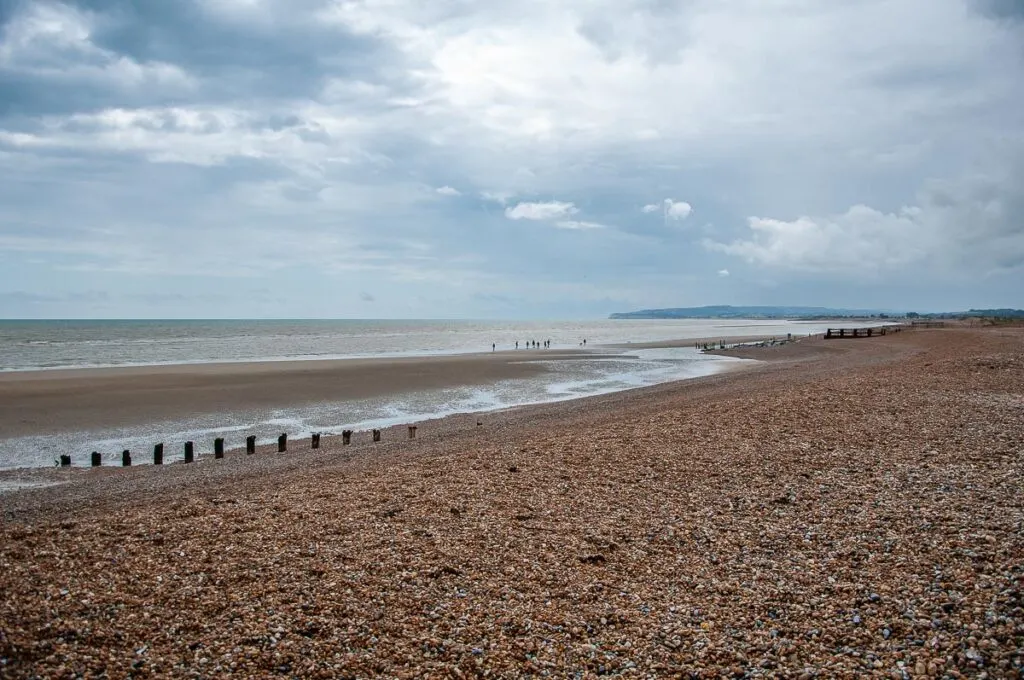
While Rye nowadays is no longer on the seashore, about two miles away from this small historic town you can find some of the finest English beaches.
Here are four of the most well-known ones:
- Camber Sands – a wide sandy beach that goes on for miles. It is flanked by a long line of tall sandy dunes. This is a very popular beach that has been featured in many films (most notably, the George Clooney-directed The Monuments Men in 2014). On warm summer days, sun worshippers flock to Camber Sands from all over East Sussex and even London.
- Rye Harbour – a pebbly beach that slopes towards the water. You can reach this beach after a short walk away from the newly-built Heritage Centre of Rye Harbour (see point 9 above).
- Winchelsea Beach – an expansive mostly pebbly beach with a gaggle of wind turbines providing a futuristic background.
- Broomhill Sands – another wide sandy beach which is just past Camber Sands. This is where extreme wind sports like kitesurfing are practiced.
The most convenient way to reach the beaches from Rye is to drive there. Otherwise, bus 102 connects Rye to Camber Sands, bus 313 connects Rye to Rye Harbour, and bus 101 connects Rye to Winchelsea Beach.
Bear in mind that this is a rather windy area. In case you want to sunbathe, for maximum comfort, it’s best to bring a windbreak. If this will be your first beach experience in England, have a look at this slightly tongue-in-cheek list of essential items for a day at the beach here.
The English Channel is rather gelid and even in summer, the water here rarely exceeds 18 degrees Celsius. Make sure that you exercise maximum caution if you decide to dip your toes in the water. There are dangerous rip tides here in addition to sandbanks and fast-rising tides!
Otherwise, the beaches near Rye are wonderful for windswept walks. In proper English fashion, bring a pair of wellies on wet days and always check the tides in advance no matter the weather!
Practical Information about Visiting Rye in East Sussex, England
Where in England is Rye?

Rye is a small town of about 5,000 inhabitants in the county of East Sussex in southeast England. It stands about two miles away from the shores of the English Channel. The rivers Rother, Tillingham, and Brede meet and flow into one another near Rye.
In the past, Rye stood in an indent of the shoreline. During high tides, the water would surround it completely on all sides. Due to the silting of the river estuary and violent storms in the past, nowadays Rye is on dry land. However, right next to the town, there are vast marshy plains. Two miles away from Rye you will find large windswept beaches of which Camber Sands is particularly well-known.
Rye is one of the best places to visit in East Sussex. On account of its quirky attractions and deep layers of history, this small town makes for a great day out both in East Sussex and coming down from either the British capital London or the English counties of Kent and West Sussex. Rye is within close proximity to several of the larger towns and cities in the southeast of England. Among them are:
- Hastings, East Sussex – about 30 mins away from Rye;
- Battle, East Sussex – about 30 mins away from Rye;
- Ashford, Kent – about 30 mins away from Rye;
- Folkestone, Kent – about 45 mins away from Rye;
- Dover, Kent – about 50 mins away from Rye;
- Eastbourne, East Sussex – about 1 h away from Rye;
- Brighton, West Sussex – about 1 h 30 mins away from Rye.
Rye is about 70 miles away from London, depending on your starting point in the British capital.
How to Reach Rye in England?
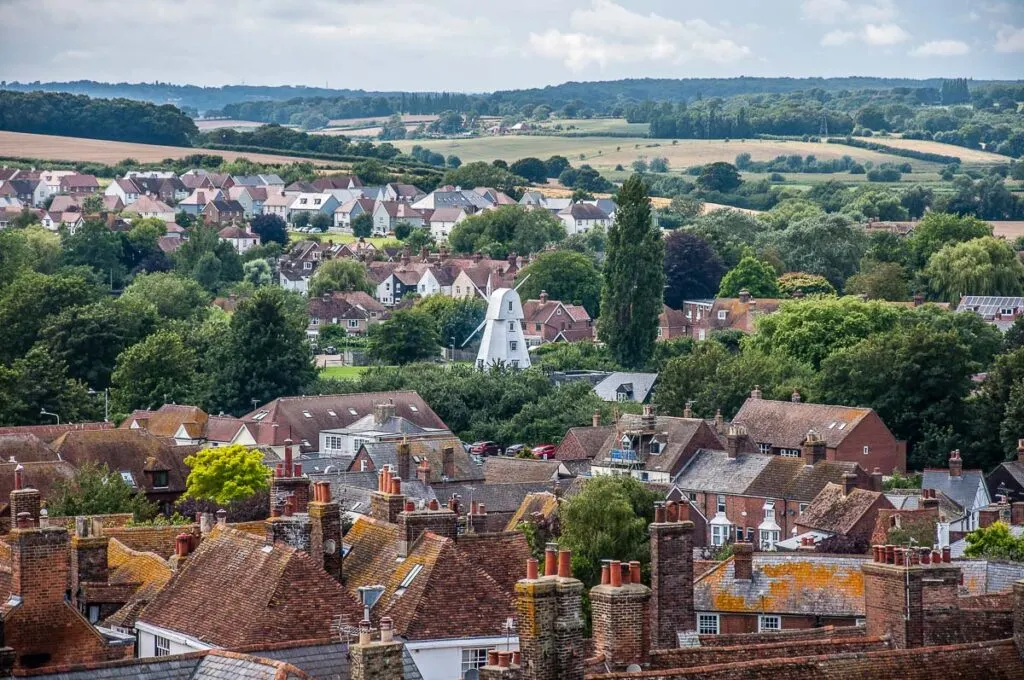
You can easily reach Rye either by train or car.
If you are planning a visit from London, arriving by train could be the better option, especially if you only have a day to spend in Rye. You can get the fast Southeastern train from St. Pancras International to Ashford International (final destination Dover Priory). Once there, get the Southern train to Rye (final destination Eastbourne).
Ashford International is only three stops (less than 40 mins) away from St. Pancras International. The journey from Ashford International to Rye is just over 20 mins (three stops). Rye station is 0,2 miles or five minutes away on foot from Rye’s town centre.
If you prefer to travel by car to Rye, here are some of the town’s main car parks:
- The Strand Car Park – perfect for Mermaid Street and the old town, this is a small car park which is flanked by some great shops selling vintage fashions and antique wares. This is where we left our car during our day trip to Rye. There are only 34 spaces here. So, on a busy day parking can be a question of luck. Stilll, for its great location right next to Mermaid Street, this is a very convenient car park.
- Lucknow Place Car Park – this car park has 61 places and it’s right next to Rye’s cricket grounds and kids’ playground. It’s next door to Landgate and it’s five minutes away on foot to the town’s High Street. There are public toilets here, too. The playground is large and with some very inventive climbing frames and swings. It’s a great place for kids to blow some steam off after a day of sightseeing with their parents.
For detailed information about council-run car parks in Rye – locations, prices, types of payments, and penalty fees – have a look at the official page of Rother District Council. This map also shows you all council-run car parks in the area. Scroll down to the end of the list to see the respective car parks in Rye.
- Rye Station – this is a privately-run large car park with 98 spaces. It’s right next to Rye’s railway station. Click on the link for details about prices and directions.
When Is the Best Time to Visit Rye in England?
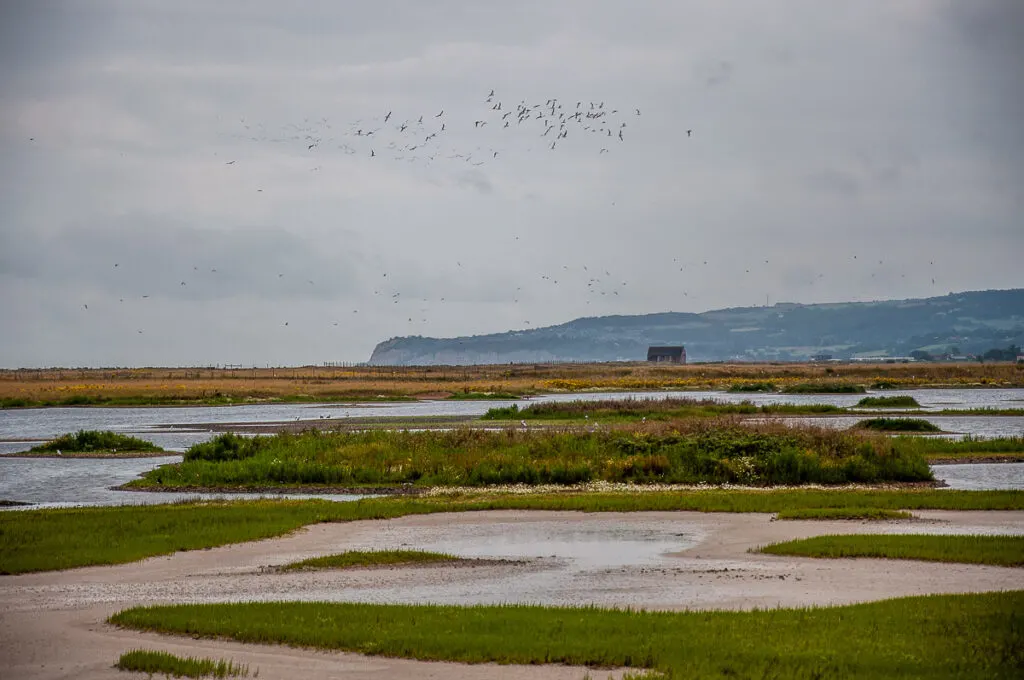
When to visit Rye in East Sussex, England depends entirely on what you want to do and see here. If it is cobbled lanes, historic houses, beautiful views, and nature walks, feel free to come at any time of the year. The town and its surroundings are gorgeous in any season.
There are many events that take place in Rye throughout the year. From a Christmas festival in winter and a scallop week in February to a Festival of the Sea in September and a bonfire in November, there is always something to do and see here. You can also click here for an up-to-date list of events in Rye. From cookery classes to a large art festival, catching an event from Rye’s annual programme will make a visit to this beautiful English town even more exciting.
In summer, there are several nearby beaches to top your tan at. Camber Sands (sandy beach) and Winchelsea Beach (mostly pebbly beach) are the two most well-known ones. It can get rather windy on the coast here, so bring a windbreaker and other essential items for a day at the beach in England.
In June, July, and August, you can expect average temperatures of about 20-25 degrees Celsius in Rye. Between November and January, rain is a given, although this being England, a drizzle or torrential rain should not surprise you at any other time of the year.
It actually drizzled several times during our August visit to Rye. A couple of times it got uncomfortably close to an icy cold downpour. Yet, the rest of the time, it was lovely and sunny, and even quite warm. Typical English weather! So, bring layers in both winter and summer.
Click for details on average monthly temperatures in Rye in East Sussex, England.
Where to Stay in Rye in England?
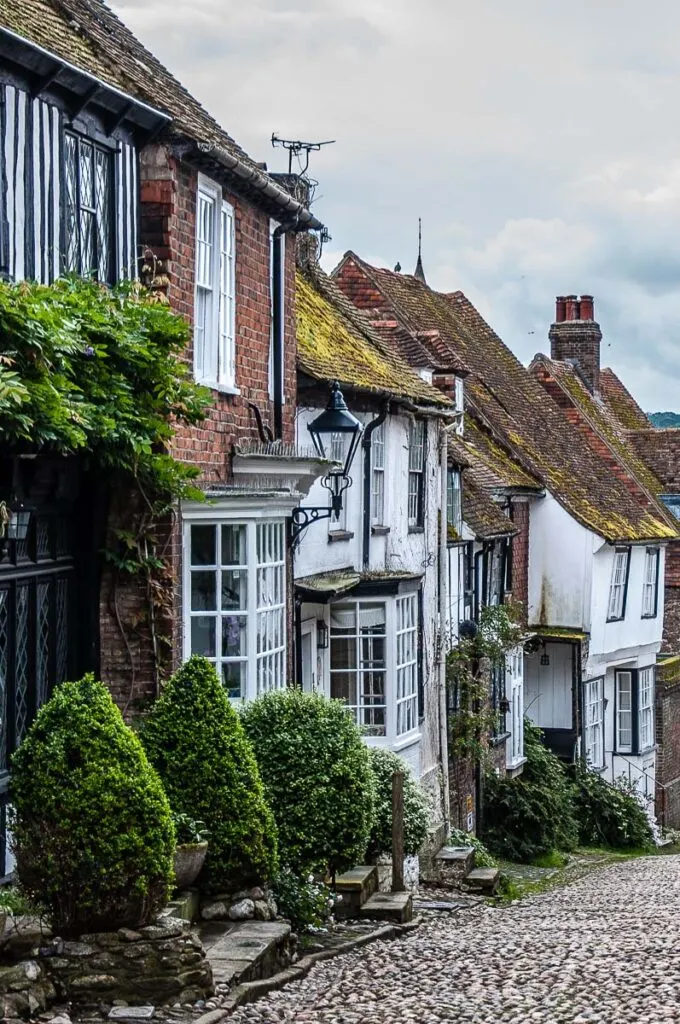
You can find all sorts and types of accommodation in and around Rye in East Sussex, England to suit any budget. From a centuries-old town house with a walled garden to cute holiday cottages, from a medieval inn on Rye’s most iconic street to a cozy guest house, there is something for everyone. You can even stay in a typical oast house with round turrets and conical roofs.
I usually prefer to book all my accommodation through Booking.com. Click to see all available options for places to stay in and around Rye, England.
If you need some visual help in terms of precise location and price range, have a look at this map. It gives you a quick idea of the prices and whereabouts of the many hotels and other forms of accommodation you can book for your stay in Rye in East Sussex, England.
You can zoom in and out in order to search for a place to stay. You can also click on the option that interests you to find out more details or to make a booking directly.
In addition, if you click on ‘Accommodation’ in the top right corner of the map and select ‘Experiences’ from the drop-down menu, then you can see some truly exciting experiences you can book directly in the area around Rye, England:
What to Pack for Rye in England?
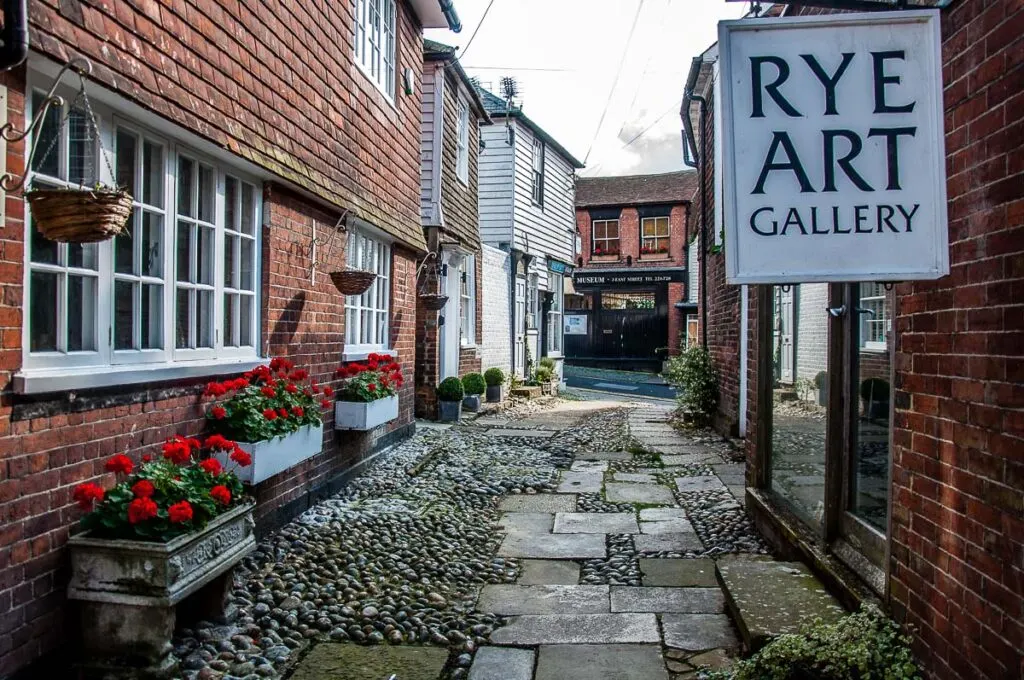
Above all, come wearing your most comfortable shoes. The historic streets of Rye are covered with cobbles which can be hard on the feet. The old town is also on top of a small hill, so expect some up and down walking and uneven surfaces.
Bring a waterproof jacket – a light one in summer and a thick, warm one in winter.
In summer, don’t forget suncream, especially, if you are planning to head to one of the nearby beaches.
The local independent shops sell a wonderful array of vintage items and antiques next to thoughtfully selected lines of gifts and handmade articles. They will tempt you to shop, shop, shop. To save plastic, I always carry a foldable shopping bag with me that can comfortably fit my impulse purchases.
What Are Some Great Tours and Activities to Do in and around Rye in England?
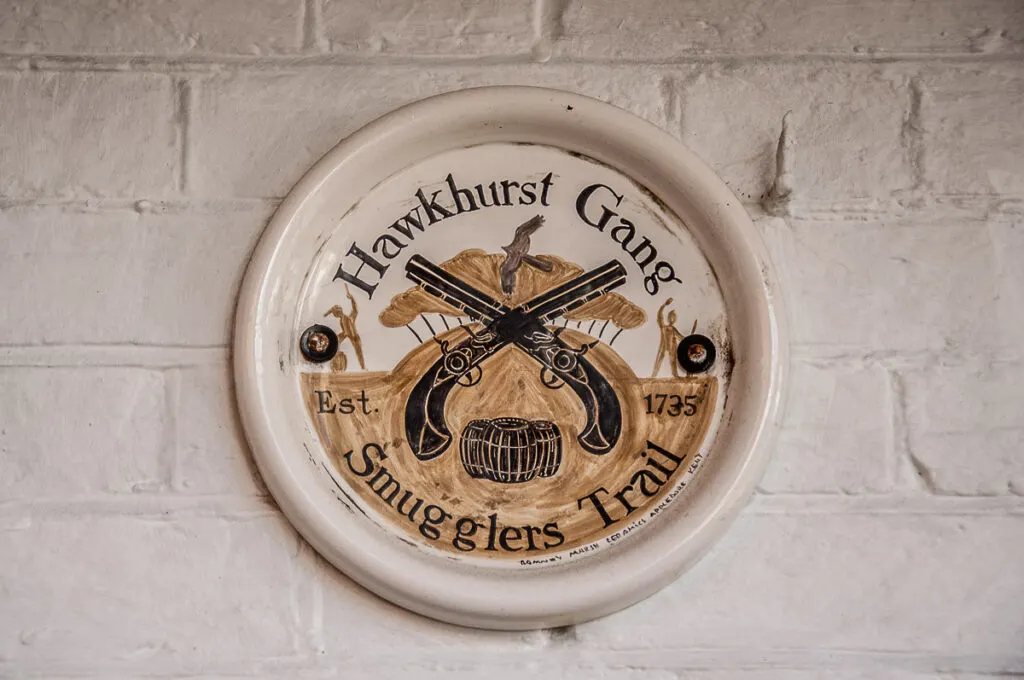
Here are a couple of tours and activities to consider for the time that you will be in Rye in East Sussex, England:
- Rye History Walks – a two-hour guided walk around Rye’s old town. An expert local guide will reveal hidden corners in this beautiful town and fascinating details about its rich in momentous events history.
- Hawkhurst Trail – this is a self-guided heritage trail spanning many different towns and villages in both East Sussex and Kent. It includes sights and locations connected to the smuggling activities of the Hawkhurst Gang. This was a notorious band of smugglers that was active in 18th-century England. Click on the link to see the official leaflet which lists the relevant places to visit in Rye.
From the comfort of your home, you can also enjoy this virtual tour of the historic Mermaid Inn in Rye.
What Else Can I See Near Rye, England?
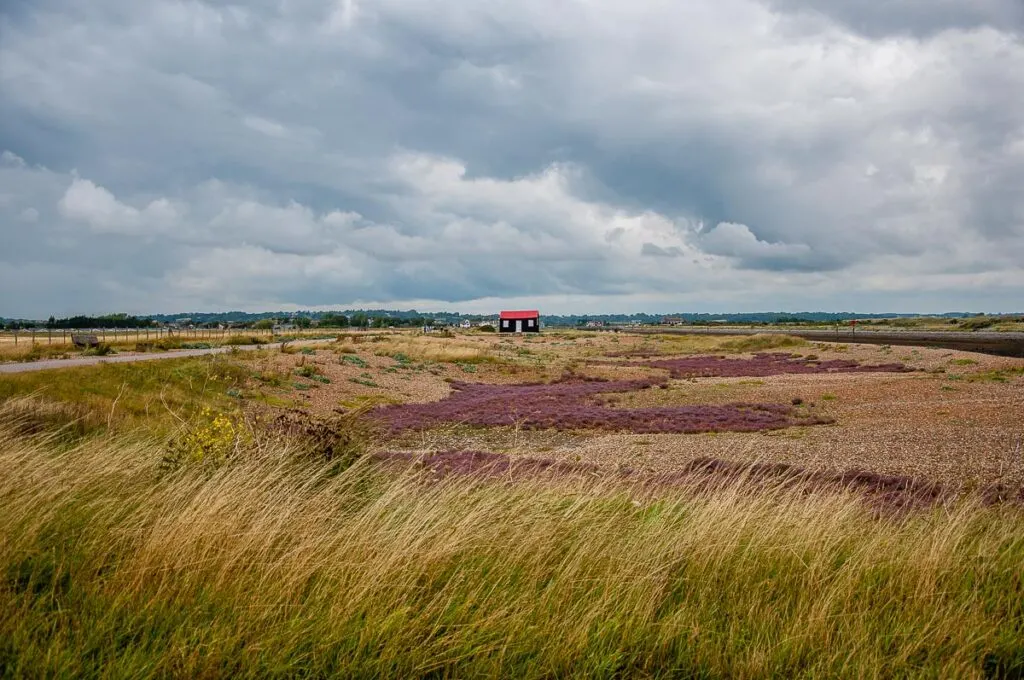
Rye’s convenient location gives you a chance to easily explore the best sights in three English counties – East Sussex, Kent, and West Sussex.
Here are some suggestions for nearby places of interest to tick off if you are spending more than a day in Rye:
- Bodiam Castle – a beautiful ruined castle surrounded by a deep moat. Come here for a romantic walk in the English countryside.
- Battle – a gorgeous small town in East Sussex where the historic Battle of Hastings took place in 1066. You can walk around the battlefield and also visit the partially ruined Battle Abbey.
- Hastings – one of my most favourite English beach towns. With a ruined castle, smuggling history, and long wide beaches, it’s the perfect day at the seaside.
- Dover – famous for its White Cliffs and one of England’s largest castles, Dover is the English town that is geographically closest to continental Europe.
- Brighton – one of England’s most famous seaside resorts, this is a vibrant city with lots to do, see, and enjoy here.
In Conclusion
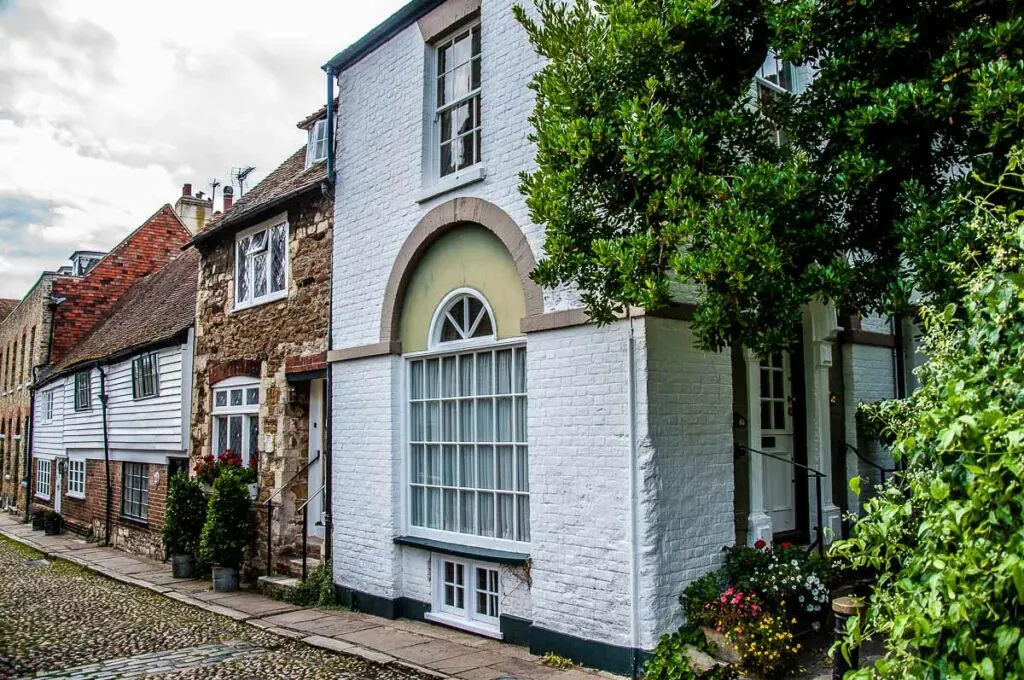
Rye is one of the most beautiful towns in England. A hidden gem, you will find it in the county of East Sussex. It’s only a couple of miles away from the shores of the English Channel and about 70 miles away from London.
Rye has a very interesting history, picturesque historic centre, lots of sights to spend time visiting, quirky shops and great food places. Right next door to it you will also find one of the most important nature reserves in England. Even better, Rye is easy to reach from London and from anywhere in three English counties – East Sussex, Kent, and West Sussex.
Spending a day, a weekend or a longer holiday in Rye is a great way to have an authentic English experience. So, in this blog post, I shared with you the ten best things to do in Rye in East Sussex, England. From local sightseeing to local eateries, from useful travel information to insider tips, everything is geared to help you plan a visit to Rye in a smooth and enjoyable way.
I hope that you feel excited about experiencing this beautiful town in the English county of East Sussex for yourself!
Have a wonderful time in Rye, England!
Now get ready quick for your trip to Rye in England!
- Consult these guidebooks.
- Book plane tickets to England.
- Book train tickets in England.
- Rent a car in England.
- Research accommodation.
- Pick local tours and activities.
More Helpful England Links for You
Travel in England: Best Towns in England
London: Free Things to Do, South Kensington Museums
Cambridgeshire: Cambridge
Cheshire: Chester
Isle of Wight: Alum Bay, Carisbrooke Castle, Osborne House, Pepperpot, Round the Island Race, St. Catherine’s Lighthouse
Hertfordshire: St. Albans Cathedral
Kent: Kent Life
Northumberland: Lindisfarne
English Lifestyle: Differences Between the English and the Italians, Memorial Benches, Allotments, Charity Shops, Beachtime
English Food: Fish and Chips
Thank you for reading! Please, leave me a comment, pin the images below or use the buttons right at the top and at the end of this blog post to share it on social media.
For more useful information like this, please, like my blog’s page on Facebook and subscribe to my strictly no-spam newsletter.
